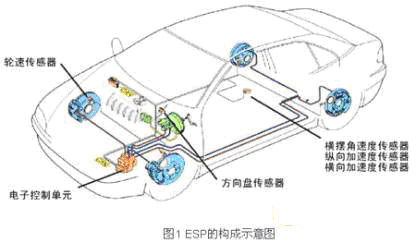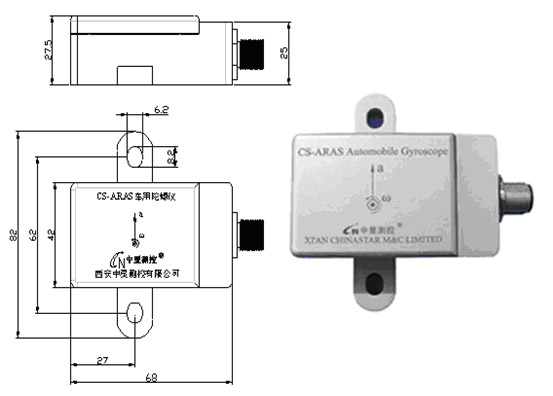Application of CS-ARAS and CS-A2LAS gyros in vehicle stability system
As cars enter thousands of households, safety becomes increasingly important. The safety of drivers and passengers is closely related to the advanced electronic systems of the vehicles used. The airbag ABS (AnTI-lock Break system) system is already a well-known conventional safety protection system. The vehicle stabilization system is a more advanced vehicle safety protection system. According to a German survey, the addition of a vehicle stabilization system can reduce vehicle accidents by 50%. Many people may only know the nouns but not their meanings. And because of the different cars, the nouns are also different.
In fact, the core of the vehicle stability system is the addition of an inertial sensor, and the angular velocity and acceleration or inclination of the vehicle's rotation are measured by the inertial sensor. Then, through the ECU, a control command is issued to a certain wheel to ensure normal and safe driving.
There are many different names for vehicle stability systems, and their substance is similar. There are mainly the following different nouns:
ESP: Electronic Stability Program.
ESC: Electronic Stability Control electronic stability control system.
VDC: Vehicle Dynamic Control.
VSC: Vehicle Stability Control body stability control system.
RSC: Roll Stability Control
DSC: Dynamic Stability Control.
ESP is based on the ABS brake anti-lock brake system. The peripheral sensors collect information such as the steering wheel rotation angle and lateral acceleration. These information are processed by the microprocessor, and then the hydraulic regulator sends a braking command to the wheel brake. To achieve the correction of side slip. Especially when turning, ie when lateral forces are acting, ESP stabilizes the vehicle and keeps it safe to drive. ABS and TCS only work in the vertical direction. ESP not only uses all the components of ABS and TCS, but also contains a yaw rate sensor and direction sensor with integrated lateral acceleration sensor.

ESC is functionally equivalent to a collection of various functions such as ABS (anti-lock brake system), EBD (electronic braking force distribution), TCS (traction control system), AYC (active yaw control), etc. It can automatically correct oversteer And understeer, and by comparing the driver ’s intention to travel with the actual direction of the car, the car can be kept on the correct route. When a deviation is detected, ESC brakes each wheel independently while reducing engine torque, helping the driver maintain control of the car. The ESC is actually a braking system that can brake four wheels separately or simultaneously, which cannot be achieved by a driver with high technology.
VDC is based on ABS and TCS to increase the angular velocity sensor of the vehicle's lateral swing during steering. The ECU controls the driving force and braking force of the inside, outside, front and rear wheels to ensure the stable state of the vehicle's lateral dynamics. The successful development of VDC makes it possible to provide active and effective driving safety guarantee to the driver under all working conditions. The system mainly uses wheel speed sensor, steering wheel angle sensor, yaw rate sensor, lateral acceleration sensor and wheel displacement sensor.
VSC will detect the driving status of the vehicle at any time. When the vehicle is in a critical cornering situation during turning, the system will automatically reduce the power output of the engine, and the front and outer wheels will brake to generate an outward force to pull the vehicle back to normal. When the vehicle is about to understeer, it also reduces the engine power output and applies brakes to the rear wheels according to the degree of understeer to allow the vehicle to return to the normal driving path.
The RSC anti-rollover stability control system uses a rotation sensor. When the driver makes a sharp turn or a quick turn, the following operations will be completed in an instant: the system records the speed of the vehicle's tilt angle change; based on this speed, the final tilt angle is calculated to determine the risk of roll Degree; if there is a risk of rollover, the brake system is activated to stabilize the vehicle; thereby gaining time for the driver to calmly deal with and deal with the dangerous situation.
DSC is a further extension of the acceleration slip control or tracking control system, which can ensure that the car can still have the best tracking performance when turning, to ensure the stability of the driving. Tracking, equipped with more advanced detection and control equipment, if you can detect the wheel speed, you can also detect the steering wheel rotation amplitude, speed, and lateral acceleration of the car, according to the information detected above , To determine whether the wheel is in danger of slipping during the turn, if there is a danger of slipping or has slipped, the computer will immediately order the brake hydraulic control system to properly brake the slipped wheel, or to reduce it The fuel injection amount and delayed ignition method reduce the output of engine power, which achieves the phenomenon of preventing tires from slipping under various driving conditions. Sex.
It can be seen from the above that in addition to the existing speed sensor and steering wheel angle sensor, these systems require a sensor that can measure the rotation of the car body to measure the angular velocity or rate of rotation, and some also need to supplement the measurement of the lateral and longitudinal lines of the vehicle. Acceleration. This leads to the problem of inertial sensors.
The development of MEMS technology (micro-electromechanical processing system), especially its high cost performance has brought the possibility and realization of vehicle stability systems. Using advanced MEMS technology, Xi'an Zhongxing Measurement and Control Co., Ltd. has developed two car gyros and stabilizers for vehicle stability control according to the requirements of domestic and foreign manufacturers to meet the needs of different customers. CS-ARAS contains an angular rate gyro and a linear acceleration, which can simultaneously measure the vehicle body's angular rate of rotation and lateral or longitudinal linear acceleration (according to the installation direction). The CS-A2LAS stabilizer contains an angular rate sensor and a two-axis acceleration sensor, which can simultaneously measure lateral or longitudinal acceleration and the angular velocity of the car body rotation. It has obtained three national patents and its products are exported to Finland, Italy and Israel.
CS-ARAS series car inertial sensors are independently developed by Xi'an Zhongxing Measurement and Control Co., Ltd. and are used to measure angular rate and acceleration. CS-ARAS series car gyroscopes are a kind of low precision gyroscopes and accelerometers. Mainly used in high-reliability automotive electronics, but also in antenna stabilization, camera, robot and other systems.
The angular rate gyroscope of the CS-ARAS series of car sensors works according to the resonator gyro principle. Two polysilicon sensitive structures, each containing a high-frequency vibrating frame, which is electrostatically driven to resonate, forming the necessary velocity element. The two outer ends of the frame form a capacitance-sensitive structure, which is sensitive to the Coriolis motion generated at the angular rate and generates an electrical signal, which is sent to the amplification and demodulation stages, so that the output is proportional to the angular rate. electric signal.
The accelerometer of the CS-ARAS series of automotive sensors is a surface MEMS polysilicon structure built on top of a silicon wafer. The structure of polysilicon reed suspended on the surface of the wafer and provides a resistance against acceleration induced force. A differential capacitor mechanism consisting of two independent fixed plates and a central plate connected to a moving mass is used to measure the deflection of the polysilicon structure proportional to acceleration, thereby generating a voltage output signal.
Main technical conditions
powered by
Input voltage 15 ± 0.25 VDC
Input current ≤30mA
Gyroscope performance
Measuring range ± 100 ° / s; ± 75 ° / s
Zero bias (at 25 ℃) 2.5 ± 0.1V
Output voltage (at 25 ℃) 0.5 ~ 4.5V
Non-linearity 0.5 ﹪ FS
Resolution ≤0.1 ° / s
Start time≤35ms
Bandwidth ≥40Hz
Noise ≤10mV
Accelerometer performance
Measuring range ± 1.8g
Zero bias (at 25 ℃) 2.5 ± 0.1V
Scale factor 1000 ± 120 mV / g
Non-linearity 0.5FSFS
Resolution 1mg
Startup time ≤35ms
Bandwidth ≥40Hz
Noise≤5mV
working environment
Operating temperature -45 ℃ — + 85 ℃
Storage temperatureï¼55 ℃ — + 100 ℃
Impact 2000g
B
Weight 150g Dimensions See outline dimensions outline dimensions and product drawings

The CS-A2LAS stabilizer was developed by Xi'an Zhongxing Measurement and Control Co., Ltd. It is used in automatic vehicle stabilization systems and is also a good sensor for many multi-axis automatic mode commercial applications.
Technical index:
Output form: analog output;
Power supply voltage: 5 ± 0.05V;
Temperature range: -40 ℃ ~ 85 ℃;
Startup time: <35ms;
Shock: 1000g;
Main index of angular rate sensor:
Range: ± 75 ° / S
Scale factor: 25 ± 2.5 (mV ∕ ° / S);
Bandwidth:> 20Hz;
Zero deviation: 2.5 ± 0.1V;
Non-linearity: ≤0.5% FS
Temperature variation of zero deviation: ± 4 ° / S;
Acceleration sensitivity: 0.2 ° / S / g;
The main indicators of the acceleration sensor:
Range: 1.5g;
Scale factor: 265 mV ∕ g;
Bandwidth:> 20Hz;
Zero deviation: 2.5 ± 0.1V;
Non-linearity: ≤0.2% FS
Dimensions:
CS-ARAS and CS-A2LAS have made anti-electromagnetic interference designs considering the electromagnetic interference of vehicles. At the same time according to different system requirements to meet the individual needs of customers. In addition to analog signal output, Can bus output has also been developed recently, and the appearance can also be made according to customer requirements.

CS-ARAS car gyros have similar functions to similar products of foreign companies. They have been tried on a small number of heavy trucks in Europe. They have also been applied to a special vehicle in China and received good reviews.
The CS-A2LAS stabilizer meets the requirements of ESP or ESC, and is being tested in several universities and research institutes in China. I believe it can meet the requirements.
Different system names are proposed and named by different car manufacturers or car electronics manufacturers. Functionally speaking, ESP, ESC, VSC and DSC are almost the same. The German Bosch and Mercedes-Benz companies use the ESP system; the continental United States, TRW, Delphi use the ESC system; the Japanese Toyota company uses the VSC system, of which the Guangzhou Toyota 09 Camry G series is; It is called the DSTC system. These systems can use one CS-A2LAS stabilizer or two CS-ARAS car gyros launched by Xi'an Zhongxing Measurement and Control Co., Ltd.
The VDC system was adopted by Nissan in Japan, and the system was also called VDC in early Bosch, Germany; Volvo such as XCPO off-road vehicles and JAGVAR brands adopted the RSC system. This type is suitable for high-adhesion coefficient roads and is mainly used to prevent rollover. Both the VDC and the RSC system can use the CS-ARAS car gyro launched by Xi'an Zhongxing Measurement and Control Company.
SMD Electric Power tansformer ,POE transformer ,EP7 SMD tansformer ,EP13SMD tansformer,EPD SMD tansformer
IHUA INDUSTRIES CO.,LTD. , https://www.ihua-coil.com